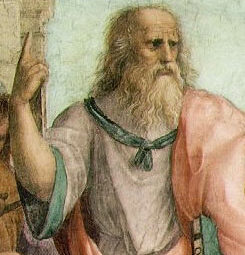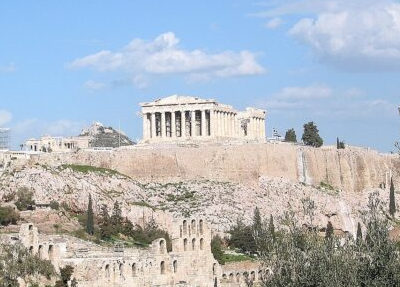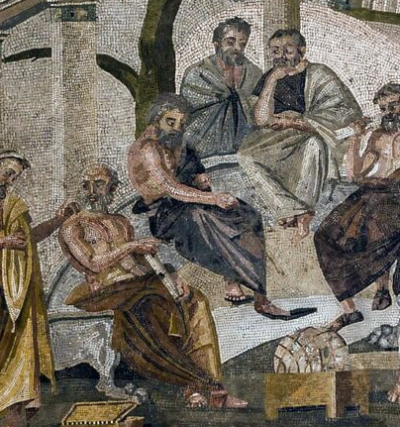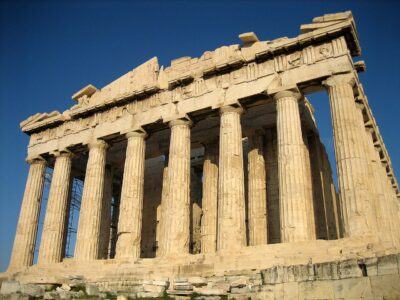プラトンのイデア論の真実を解説!イデアの意味と起源 歴史的背景

Explaining the Truth Behind Plato’s Theory of Ideas: The Meaning, Origins, and Historical Background of the Ideas
イントロダクション
哲学の歴史において、古代ギリシャの思想家たちは、人間の存在や宇宙の本質についての洞察を追求し、多くの重要な問いに挑戦しました。
その中でも、プラトン(Plato)はその名を刻み込むほどの影響力を持つ哲学者の一人です。
彼の洞察力に満ちた思想は、現代においてもなお深い意味を持ち、我々の考え方や価値観に影響を与えています。
「プラトンのイデア論」に焦点を当て、彼の哲学の中心的なアイディアや彼の時代における重要性について探求します。
我々は彼の哲学がなぜ今なお重要なのか、そしてその思想がなぜ価値を持つのかを考察します。
プラトンの哲学は、現代の社会や知識の基盤を築く上で欠かせないものとなっています。
その深い思索は、個人の人生から政治的な体制まで、幅広い領域にわたって影響を及ぼしており、その影響力は時を超えて輝きを放っています。
プラトンを知る上で、まず知っておかなければならないのは当時の時代背景です。
Introduction
In the history of philosophy, ancient Greek thinkers pursued insights into human existence and the nature of the universe, tackling many fundamental questions. Among them, Plato stands out as one of the most influential philosophers, leaving an indelible mark on the field.
His profoundly insightful ideas continue to hold significant meaning today, shaping our ways of thinking and our values. Focusing on “Plato’s Theory of Forms,” we will explore his central philosophical concepts and their importance during his time.
We will examine why Plato’s philosophy remains relevant and valuable today. Plato’s thought is essential in forming the foundation of modern society and knowledge.
His deep reflections influence a wide range of areas, from individual lives to political systems, and their impact continues to shine through the ages. To truly understand Plato, it is crucial to first be aware of the historical context of his era.

プラトンは古代ギリシャの生まれで、当時ギリシャは世界の中心でした。
政治的、文化的、学問的にも他に追随を許さない立場にいました。
その後マケドニア帝国に滅ぼされ黄金期は終わるのですが、そんな境遇のなかだからこそプラトンがイデア論にたどり着いたというのが1点目です。
2点目として当時の宗教観です。古代ギリシャが栄えた時代は紀元前4世紀周辺ですが、当時ギリシャ周辺で宗教として確立していたのはユダヤ教くらいなもので、ギリシャ神話が思想のもととなることが多かったそうです。
イデア論の本質を考えた時にこれらの背景がどう影響を及ぼしたのがプラトンを紐解くカギとなります。
Plato was born in ancient Greece, a time when Greece was considered the center of the world. Politically, culturally, and academically, Greece held a preeminent position unmatched by any other civilization.
However, Greece’s golden age came to an end with its conquest by the Macedonian Empire. It was within this context of decline that Plato developed his Theory of Forms, which is the first point to consider.
The second point is the religious context of the time. Ancient Greece flourished around the 4th century BCE, and the predominant religious influence was Greek mythology, with Judaism being one of the few established religions in the surrounding region.
Understanding these historical and religious backgrounds is crucial to unraveling the essence of Plato’s Theory of Forms and its development.


プラトンは、古代ギリシャの哲学者であり、ソクラテスの弟子であることで広く知られています。
彼の生涯は、哲学の歴史において重要な位置を占めるものであり、その思想は今なお私たちに影響を与えています。
プラトンは紀元前427年にアテネで生まれました。
彼の家族は政治的な影響力を持っており、幼少期から教育に恵まれました。
ソクラテスとの出会いが、彼の哲学的な興味を刺激しました。
ソクラテスの思想の中で、真理を探求し、知識を深めることの重要性に魅了されたプラトンは、その影響を受けつつ独自の哲学体系を築く道を歩むこととなります。
Plato is widely known as an ancient Greek philosopher and a disciple of Socrates. His life holds a significant place in the history of philosophy, and his ideas continue to influence us today.
Plato was born in Athens in 427 BCE. His family was politically influential, providing him with a privileged education from a young age. His encounter with Socrates sparked his philosophical interests.
Plato was captivated by Socrates’ emphasis on seeking truth and deepening knowledge. Inspired by Socrates, he embarked on the path of developing his own unique philosophical system.

A mosaic depicting the Academy in Plato’s time
プラトンはアカデメイアと呼ばれる学園を設立し、そこで哲学を教える一方、自身のアイディアを展開しました。
彼の思想は「イデア論」として知られ、物事の本質は現実世界ではなく、超越的なイデアの世界に存在すると考えました。
また、政治においても彼は「国家」でその理想的な政治体制を描きました。
プラトンは哲学だけでなく政治や教育にも熱心で、そのアイディアは後世の思想家や政治家にも影響を与えました。
しかし、晩年は彼の政治的な理想が実現することなく、失望とともに亡くなりました。
プラトンの生涯は、哲学の進化と古代ギリシャの知識体系の中で輝かしい一章として刻まれています。
彼の思想は、現代の哲学や政治、教育においてもなお重要な影響を持っており、その遺産は永遠に私たちの知的探求を鼓舞し続けています。
Plato founded a school known as the Academy, where he taught philosophy and developed his ideas. His philosophy, known as the “Theory of Forms,” posits that the essence of things exists not in the physical world but in a transcendent realm of Forms.
In politics, he outlined his vision of an ideal political system in his work “The Republic.” Plato was deeply involved not only in philosophy but also in politics and education, and his ideas influenced many later thinkers and politicians.
However, he passed away in disappointment, as his political ideals were never realized. Plato’s life remains a brilliant chapter in the evolution of philosophy and the body of knowledge in ancient Greece.
His thoughts continue to be influential in modern philosophy, politics, and education, inspiring our intellectual pursuits to this day.
プラトンのイデア論とは?
What is Plato’s Theory of Forms?
イデア論は、哲学の一派で、物質の世界とは別次元の「イデア界」が存在するという理論です。
この考え方をシンプルに言うと、「ものごとの本質はイデア界にあって、そこで永遠不変のまま認識されている」ということです。
たとえば、赤いリンゴの「赤い」という色や性質は、物質の世界だけでなく、イデア界に存在する「赤」というイデアによって説明されると言われています。
つまり、物質界のリンゴが赤いのは、その背後にあるイデア界の「赤」が影響しているとされるわけです。
このイデア論のアイディアは、古代ギリシャの哲学者プラトンによって提唱されました。
イデア論は物質の変化や多様性に対する新しい視点を提供しており、形而上学的な問いに向き合う一つのアプローチと言えます。
イデア論にはいくつかの議論や疑問もあります。
物質界とイデア界の関係性や、イデア界の存在自体の立証についての論争が続いています。しかし、これらの議論は哲学の深い探求の一環として、今も続けられています。
要するに、イデア論は物質界の裏にある本質や真理を追求する哲学的なアイディアであり、物事の本質的な意味や背後にある原因を理解する手助けとなる可能性があります。
The Theory of Forms is a philosophical concept suggesting the existence of a separate dimension called the “Realm of Forms,” distinct from the material world.
Put simply, it proposes that the essence of things resides in the Realm of Forms, where they are perceived in an eternal and unchanging state.
For instance, the color and properties of a red apple are said to be explained by the Form of “red” existing in the Realm of Forms, not solely in the material world.
In other words, the redness of a material apple is influenced by the Form of “red” in the underlying Realm of Forms.
This idea of the Theory of Forms was introduced by the ancient Greek philosopher Plato.
The Theory of Forms offers a new perspective on the changes and diversity in the material world, presenting one approach to metaphysical inquiries.
There are various debates and questions surrounding the Theory of Forms, including discussions on the relationship between the material world and the Realm of Forms, as well as the validation of the existence of the Realm of Forms itself. However, these discussions continue as part of the profound exploration of philosophy.
In essence, the Theory of Forms is a philosophical idea that seeks to uncover the essence and truth behind the material world, potentially aiding in understanding the fundamental meaning of things and the causes behind them.
イデアの意味とは「理想の真理」ということ
The meaning of “Idea” is the concept of “ideal truth.”
物質界のものは常に変化し、一時的であり、不完全であるという考えが広く受け入れられています。
しかし、この考えには別の側面も存在します。
それが、イデア論という哲学的な理論です。
イデア論は、物質界とは異なる高次元の領域である「イデア界」が存在し、その中には変化しない永遠の存在があるという立場を提唱しています。
この理論は、物質界の変化や一時性、不完全さに対する対照的なアプローチを提供しています。
イデア論の観点から見ると、物質界のものは一時的であるのは当然であり、その変化や不完全さはイデア界の永遠の存在とは対照的な性質だとされています。
イデア界に存在するイデアたちは変わらず、不変であり、完全な存在として認識されます。
この理論の一例として、赤いリンゴの「赤い」という性質を考えてみましょう。
物質界のリンゴは時間とともに変化し、腐ったり色褪せたりしますが、イデア界に存在する「赤」というイデアは常に変わらず、その色の完全さを保っているとされます。
つまり、物質界の変化は一時的である一方、イデア界の存在は永遠不変であり、完全性を持つという考え方です。
この対比を通じて、イデア論は物質界の現象を深く理解するための一つの視点を提供しています。
ただし、イデア論には独自の論争や問題も存在し、その妥当性や根拠についてはさまざまな立場が存在します。
総じて言えることは、物質界の変化とイデア界の永遠不変の関係性は、哲学的な洞察を通じて考える価値があるテーマであるということです。
この世にあるものの本質はイデアである
プラトンのイデア論に関する考察において注目すべき点は、絶対的な不変性を追求しているということです。
イデア論は、プラトンが提唱した哲学的な理論で、物質界とは異なる高次元の「イデア界」が存在し、その中には変化しない永遠の存在や完全なものがあるとされています。
この理論の背後には、時の流れによる変化や不完全さに対抗し、真実や本質を求めるプラトンの哲学的スタンスが反映されています。
イデア論において重要なのは、イデア界に存在するものは変化しないという点です。
物質界の対象は時とともに変わり、不完全な部分を持ちますが、イデア界にあるイデアたちは常に変わらず、その完全性を保っているとされます。
これによって、プラトンは物質界の一時的な変化や不確かさに対して、絶対的な真実や不変の本質を見出そうとしたわけです。
また、このイデア論の背後には当時の時代背景も影響している可能性があります。
プラトンの生きた時代は戦乱の時代であり、理不尽や価値の変動が日常的でした。
こうした不安定な状況に対して、プラトンはイデア論を通じて、不変の理念や真理を追求し、現実の混乱から抜け出す道を提案したとも言えます。
要するに、プラトンのイデア論は物質界の一時的な変化や不完全さに対抗する哲学的アプローチであり、絶対不変の存在や真実を求める姿勢が背後にあると言えます。
この考え方は、彼の時代背景や哲学的な探求心から生まれたものであり、現代においても真実の探求や本質の理解に対する示唆を与えています。
The belief that things in the material world are always changing, temporary, and imperfect is widely accepted. However, there is another perspective to consider: the philosophical theory known as the Theory of Forms.
The Theory of Forms suggests the existence of a higher-dimensional realm called the “Realm of Forms,” distinct from the material world, where eternal and unchanging entities reside.
From this viewpoint, the impermanence and imperfection of the material world are contrasted with the eternal existence found in the Realm of Forms.
For example, let’s consider the property of “redness” in a red apple. While the material apple undergoes changes over time, the Form of “red” in the Realm of Forms remains unchanged, maintaining its perfect color.
In essence, while the material world undergoes temporary changes, the existence in the Realm of Forms is eternal and immutable, embodying perfection.
This contrast provides a deeper understanding of phenomena in the material world from the perspective of the Theory of Forms.
However, the Theory of Forms is not without its own debates and issues, with various perspectives on its validity and justification.
In general, the relationship between the changing nature of the material world and the eternal immutability of the Realm of Forms is a theme worthy of philosophical exploration.
The significant aspect to note in Plato’s contemplation of the Theory of Forms is his pursuit of absolute immutability.
Plato’s Theory of Forms is a philosophical proposition suggesting the existence of a higher-dimensional “Realm of Forms,” distinct from the material world, where eternal and perfect entities reside.
This theory reflects Plato’s philosophical stance of seeking truth and essence amidst the changes and imperfections of the material world.
A crucial aspect of the Theory of Forms is the belief that entities in the Realm of Forms do not undergo changes.
While objects in the material world may change over time and possess imperfections, Forms in the Realm of Forms remain unchanged, preserving their perfection.
Plato sought to discover absolute truths and immutable essences amidst the temporary changes and uncertainties of the material world.
Furthermore, the historical context of Plato’s era may have influenced the development of the Theory of Forms.
Plato lived in a turbulent period of warfare, where injustice and fluctuating values were commonplace.
In response to such instability, Plato proposed the Theory of Forms as a means to pursue immutable ideals and truths, offering a path out of the chaos of reality.
In summary, Plato’s Theory of Forms presents a philosophical approach to counter the temporary changes and imperfections of the material world, driven by a quest for absolute and immutable truths.
This perspective emerged from both his historical context and philosophical inquiries, providing insights into the pursuit of truth and understanding essence even in modern times.
真実はすべてイデアの中にある
All truth resides within the realm of Ideas.
プラトンのイデア論に関する考察において注目すべき点は、絶対的な不変性を追求しているということです。
イデア論は、プラトンが提唱した哲学的な理論で、物質界とは異なる高次元の「イデア界」が存在し、その中には変化しない永遠の存在や完全なものがあるとされています。
この理論の背後には、時の流れによる変化や不完全さに対抗し、真実や本質を求めるプラトンの哲学的スタンスが反映されています。
イデア論において重要なのは、イデア界に存在するものは変化しないという点です。
物質界の対象は時とともに変わり、不完全な部分を持ちますが、イデア界にあるイデアたちは常に変わらず、その完全性を保っているとされます。
これによって、プラトンは物質界の一時的な変化や不確かさに対して、絶対的な真実や不変の本質を見出そうとしたわけです。
また、このイデア論の背後には当時の時代背景も影響している可能性があります。
プラトンの生きた時代は戦乱の時代であり、理不尽や価値の変動が日常的でした。
こうした不安定な状況に対して、プラトンはイデア論を通じて、不変の理念や真理を追求し、現実の混乱から抜け出す道を提案したとも言えます。
要するに、プラトンのイデア論は物質界の一時的な変化や不完全さに対抗する哲学的アプローチであり、絶対不変の存在や真実を求める姿勢が背後にあると言えます。
この考え方は、彼の時代背景や哲学的な探求心から生まれたものであり、現代においても真実の探求や本質の理解に対する示唆を与えています。
In examining Plato’s Theory of Forms, one notable aspect to consider is his pursuit of absolute immutability.
The Theory of Forms, a philosophical theory proposed by Plato, suggests the existence of a higher-dimensional “Realm of Forms” distinct from the material world, where eternal and perfect entities reside.
Behind this theory lies Plato’s philosophical stance of seeking truth and essence amidst the changes and imperfections of the material world.
A crucial point in the Theory of Forms is that entities in the Realm of Forms do not undergo changes.
While objects in the material world may change over time and possess imperfections, Forms in the Realm of Forms remain unchanged, preserving their perfection.
Through this, Plato sought to discover absolute truths and immutable essences amidst the temporary changes and uncertainties of the material world.
Furthermore, the historical context of Plato’s era may have influenced the development of the Theory of Forms.
Plato lived in a turbulent period of warfare, where injustice and fluctuating values were commonplace.
In response to such instability, Plato proposed the Theory of Forms as a means to pursue immutable ideals and truths, offering a path out of the chaos of reality.
In essence, Plato’s Theory of Forms presents a philosophical approach to counter the temporary changes and imperfections of the material world, driven by a quest for absolute and immutable truths.
This perspective emerged from both his historical context and philosophical inquiries, providing insights into the pursuit of truth and understanding essence even in modern times.
イデア論を唱えたプラトンの歴史的背景
The historical context of Plato’s advocacy of the Theory of Forms.
プラトンが提唱したイデア論の歴史的背景を探るためには、ソクラテスの尋問法が重要な役割を果たしています。
この哲学的な展開は、真理への追求の方向性を影響深く変えました。
ソクラテスは、真理の探求において「何も知らない」という謙虚な立場をスタート地点としました。
このアプローチによって、人々は自己満足に陥るのではなく、常に新たな知識を求める姿勢を持つことができると考えました。
このスタンスが、プラトンが広義の意味でのイデア論に辿り着く一助となったと見られています。
プラトンのイデア論は、ソクラテスの思想を基盤に発展しています。
ソクラテスが真理の探求を通じて「知識の無知」を強調したことから、プラトンは物質界の変化や一時性に疑問を持ち、不変で完全な存在を求める方向に向かったのです。
イデア論は、物質界の裏にある永遠の存在を考える哲学的アイデアであり、ソクラテスの尋問法がその基礎を築いたと言えます。
また、ギリシャの歴史的背景もプラトンの考え方に影響を与えました。
ギリシャは黄金時代から転落し、政治的な混乱や社会的な問題が生じていました。
この状況は、自己の存在意識を問い直す契機となりました。
プラトンはこの混乱を通じて、物質界の現象だけでなく、それらの背後にある本質や真理を追求する重要性を感じたとされています。
To explore the historical background of Plato’s advocacy of the Theory of Forms, Socrates’ method of inquiry plays a significant role.
This philosophical development deeply influenced the direction of the quest for truth.
Socrates initiated his pursuit of truth from a humble position of “knowing nothing.”
Through this approach, it was believed that individuals could maintain an attitude of seeking new knowledge rather than falling into complacency.
This stance is thought to have contributed to Plato’s eventual development of the Theory of Forms in a broad sense.
Plato’s Theory of Forms builds upon the foundation of Socratic thought.
Drawing from Socrates’ emphasis on the “ignorance of knowledge” through the pursuit of truth, Plato questioned the changes and temporality of the material world, aiming towards seeking immutable and perfect entities.
The Theory of Forms is a philosophical idea that contemplates the eternal entities behind the material world, with Socratic inquiry laying its groundwork.
Moreover, the historical background of Greece also influenced Plato’s thinking.
Greece had fallen from its golden age, facing political turmoil and societal issues.
This situation prompted a reevaluation of one’s existence.
Through this turmoil, Plato felt the importance of not only examining the phenomena of the material world but also pursuing the essence and truth behind them.

“Death of Socrates” by Jacques-Louis David, 1787, depicts the final moments of Socrates.
総括すると、イデア論を唱えたプラトンの歴史的背景を考察すると、ソクラテスの尋問法とギリシャの社会的状況が重要な影響を与えたことが分かります。
ソクラテスの知識の無知という哲学的スタンスがプラトンの思考を導き、ギリシャの混乱が真理と本質への追求を加速させたのです。
これらの要因が合わさって、プラトンのイデア論が生まれ育まれたのです。
In summary, examining the historical context behind Plato’s advocacy of the Theory of Forms reveals the significant influence of Socrates’ method of inquiry and the societal circumstances in Greece.
Socrates’ philosophical stance of “knowing nothing” guided Plato’s thinking, while the tumultuous situation in Greece accelerated the pursuit of truth and essence.
These factors combined to give rise to Plato’s Theory of Forms.
プラトンの関連書籍を3冊紹介します
Here are three books related to Plato that I’d recommend:
- 『国家』 プラトンの代表的な著作です。プラトンの政治観を哲学的に論じています。
- 『饗宴 』 愛についてのプラトンの哲学的な名言が詰まっている作品です。
- 『ソクラテスの弁明』 プラトンの哲学の基礎となるソクラテスの思想について理解するための入門書として有名です。
- Here are three books by Plato that I’d recommend:
- “The Republic”: This is one of Plato’s most famous works, where he philosophically discusses his political views. It delves into the nature of justice, governance, and the ideal state.
- “Symposium”: This work is filled with philosophical insights on love by Plato. It’s a collection of speeches delivered at a banquet, exploring various aspects of love and desire.
- “Apology”: This book is famous as an introductory text to understand Socrates’ philosophy, which forms the foundation of Plato’s philosophy. It presents Socrates’ defense speech during his trial, offering insights into his philosophical approach and worldview.
- These books provide a rich exploration of Plato’s philosophical ideas and are essential readings for anyone interested in classical philosophy.
まとめ
プラトン: イデア論の提唱者
イデア論は、物質界に存在する形あるものに関する哲学的理論であり、その思想を唱えたのがプラトンです。
イデア論は、物質の背後にある本質や真理を探求し、形あるものの変化に対抗する哲学的なアプローチです。プラトンは、イデア論を通じて物質界の一時的な変化に対して、永遠不変の存在を見出そうとしました。
また、イデア論は現代の認識論にも影響を与えています。
プラトンの考えは紀元前から始まる論理的な哲学の一翼を担っており、知識や真理の本質に迫るための基盤となっています。
総括すると、プラトンはイデア論の提唱者として、物質界の裏にある本質や真理を追求する哲学的な視点を提供しました。
その思想は、形あるものの背後にある普遍的な真理を理解し、知識の本質に迫るための重要な枠組みとなっています。
Summary:
Plato: Advocate of the Theory of Forms
The Theory of Forms is a philosophical theory concerning the existence of tangible things in the material world, and it was advocated by Plato.
The Theory of Forms seeks to explore the essence and truth behind material objects, presenting a philosophical approach that opposes the changes observed in tangible things. Through the Theory of Forms, Plato aimed to discover eternal and unchanging entities amidst the temporary changes in the material world.
Furthermore, the Theory of Forms has also influenced contemporary epistemology.
Plato’s ideas represent a logical aspect of philosophy dating back to antiquity, serving as a foundation for probing the essence of knowledge and truth.
In conclusion, Plato, as the proponent of the Theory of Forms, provided a philosophical perspective on the pursuit of the essence and truth behind the material world.
His philosophy offers a framework for understanding the universal truths behind tangible objects and delving into the essence of knowledge.

Warning: Undefined variable $comment_form_sns_tags in /home/ktsky/philosophy-kayak.com/public_html/wp-content/themes/shaper/comments.php on line 27